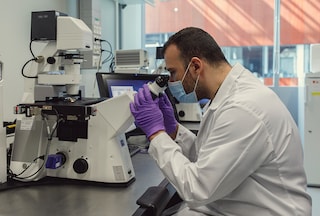
Our 2025 Roadmap goals
See our full 2025 roadmapMAXIMIZE THE BENEFITS OF SMOKE-FREE PRODUCTS
Develop and commercialize science-based smoke-free alternatives, making them available in 100 markets (of which at least half are low- and middle-income markets) and continuing to increase the total number of users.
Deploy robust youth access prevention programs in indirect retail channels and ensure that sales of our products abide by our Marketing Codes.
Key performance indicators to track our progress
By the end of 2024, our smoke-free products were available for sale in 95 markets*, of which 49 percent were low- and middle-income markets**. We estimate that approximately 38.6 million adults worldwide were using our smoke-free products***.
*, **, and ***, see PMI's Integrated Report 2024.

See full performance metrics
view dataLearn more about PMI’s Sustainability Index in our Integrated Report 2024. See the full performance metrics and related footnotes here.
The right thing to do
The best choice a person can make is to never start smoking. For those who do smoke, their best course of action is to quit. However, many do not. Those adults who would otherwise continue to smoke should have access to nicotine-containing products that represent a better alternative than continued smoking.
Read moreThe business case
Through our early and sustained investment in R&D and consequent leadership in technology and innovation, we have built a powerful position and competitive advantage in scientifically substantiated smoke-free products that can help accelerate the decline of cigarette smoking.
Read more
Our progress in 2024
Read more in our Integrated ReportThis online content about our Integrated Report should be read in conjunction with PMI’s Integrated Report 2024. This report includes metrics that are subject to uncertainties due to inherent limitations in the nature and methods for data collection and measurement. The precision of different collection and measurement techniques may also vary. This report includes data or information obtained from external sources or third parties. Unless otherwise indicated, the data contained herein cover our operations worldwide for the full calendar year 2024 or reflect the status as of December 31, 2024. Where not specified, data comes from PMI financials, nonfinancials, or estimates.
Unless explicitly stated, the data, information, and aspirations in this report do not incorporate PMI’s wellness and healthcare business, Aspeya. Regarding the Swedish Match acquisition, completed late 2022, unless otherwise indicated, this report includes information pertaining to its sustainability performance. Please also refer to "This report at a glance" on page 2 of the PMI’s Integrated Report 2024 for more information. Aspirational targets and goals do not constitute financial projections, and achievement of future results is subject to risks, uncertainties and inaccurate assumptions, as outlined in our forward-looking and cautionary statements on page 206. In PMI’s Integrated Report 2024 and in related communications, the terms “materiality,” “material,” and similar terms are defined in the referenced sustainability standards and are not meant to correspond to the concept of materiality under the U.S. securities laws and/or disclosures required by the U.S. Securities and Exchange Commission.










